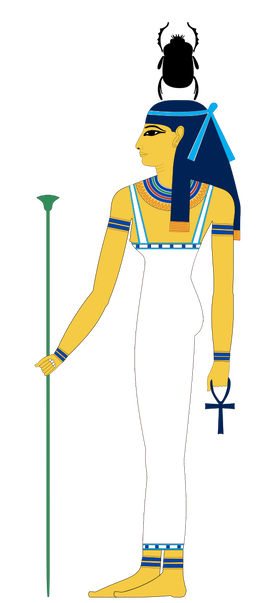Per- Ȧusāaset
𓂻𓏲𓋴𓉻𓂝𓄿𓋴𓏏𓆇𓆗
MDC: iw.s aA.s
Gardiner:
Budge:
Alt Egyptian: Jw=s ˁ3=s
Demotic:
Transliteration:
Coptic:
Hebrew:
Greek: Saosis
Arabic:
English: Iusaaset
Kemetic:
Alt:
IPA: Juzaas, Jusas, Iuesaes, Juesaaes
Pronounced: Ȧus-āah-set, Ius-āah-set (Possibly)
Meaning: "She who grows as she comes" - /iw/𓇍𓅱 "Come" + /.s/ 𓋴 "She" + /aA/𓉻𓂝 "large/huge" + /.s/ 𓋴 "She"
Gardiner:
Budge:
Alt Egyptian: Jw=s ˁ3=s
Demotic:
Transliteration:
Coptic:
Hebrew:
Greek: Saosis
Arabic:
English: Iusaaset
Kemetic:
Alt:
IPA: Juzaas, Jusas, Iuesaes, Juesaaes
Pronounced: Ȧus-āah-set, Ius-āah-set (Possibly)
Meaning: "She who grows as she comes" - /iw/𓇍𓅱 "Come" + /.s/ 𓋴 "She" + /aA/𓉻𓂝 "large/huge" + /.s/ 𓋴 "She"
Home:
Dynasty:
Temple: Worshiped in Iunu/iwnw/Heliopolis
Nome:
Consort
Tem/Atum married to Iusaaset at Heliopolis (Iunu/iwnw)
Children
Parents
Alternative Parentage
Siblings
Female/Male counter part
Atum
Priest names
Followers
Features
a woman with a scarab on her head.
Symbols
acacia tree
Roles
Primal goddess the grandmother of all of the gods. Goddess who personifies the "hand of God" with which Atum created the world from himself. An other tradition stated she emerged from the crown of the earth god Geb. Egyptologist Stephen Quirke suggests that Nebethetepet (Considered the same goddess early on) was the aspect that was abundance and Ȧusāaset was the aspect of growth represented tow aspects of creation, they represented two aspects of creation.
Interesting facts
Hybrid gods
Connection to other gods
Hut-Hor/Hathor
Nebethetepet/ nb.t-Htp.t/ 𓎟𓏏𓊵𓏏𓊪𓏏𓆇𓆗 "Lady of the Offerings" or "Satisfied Lady" (early texts say she is the same Goddess as Ȧusāaset, after MK they were two different Goddesses)
Celebrations
Offering items
Protects
Other names
Names derived from the God's name
Epitaphs
Iusaaset at Heliopolis
Dynasty:
Temple: Worshiped in Iunu/iwnw/Heliopolis
Nome:
Consort
Tem/Atum married to Iusaaset at Heliopolis (Iunu/iwnw)
Children
Parents
Alternative Parentage
Siblings
Female/Male counter part
Atum
Priest names
Followers
Features
a woman with a scarab on her head.
Symbols
acacia tree
Roles
Primal goddess the grandmother of all of the gods. Goddess who personifies the "hand of God" with which Atum created the world from himself. An other tradition stated she emerged from the crown of the earth god Geb. Egyptologist Stephen Quirke suggests that Nebethetepet (Considered the same goddess early on) was the aspect that was abundance and Ȧusāaset was the aspect of growth represented tow aspects of creation, they represented two aspects of creation.
Interesting facts
Hybrid gods
Connection to other gods
Hut-Hor/Hathor
Nebethetepet/ nb.t-Htp.t/ 𓎟𓏏𓊵𓏏𓊪𓏏𓆇𓆗 "Lady of the Offerings" or "Satisfied Lady" (early texts say she is the same Goddess as Ȧusāaset, after MK they were two different Goddesses)
Celebrations
Offering items
Protects
Other names
Names derived from the God's name
Epitaphs
Iusaaset at Heliopolis

